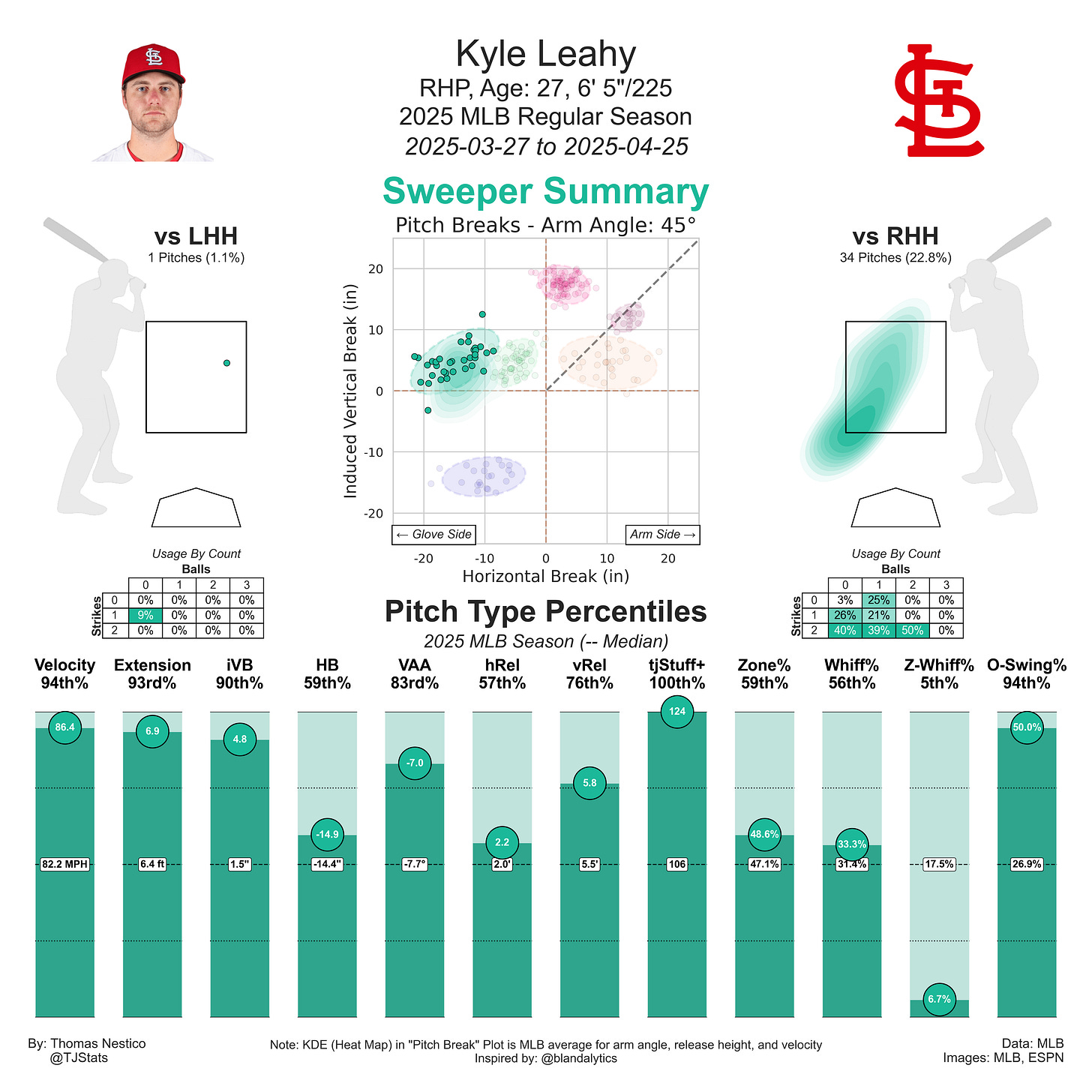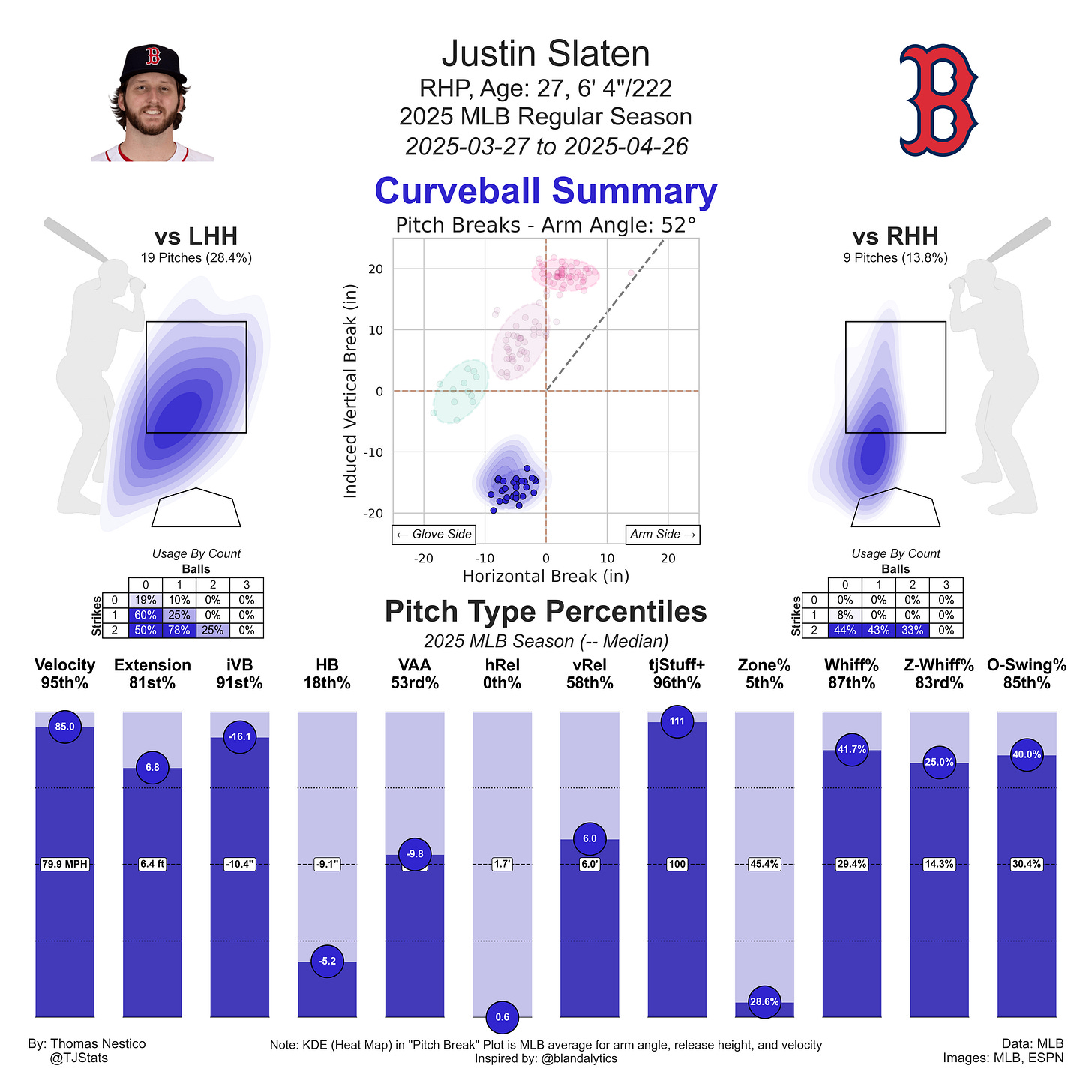The 5 Nastiest Pitches in MLB
Hayden Birdsong, Kyle Leahy, Justin Slaten, Brendon Little, Ben Casparius
To myself, pitching is the most fascinating part of baseball. The way pitches move in space as they torpedo toward the plate at high speeds will always amaze me. This article will highlight 5 of my favourite pitches currently thrown in MLB while answering what makes them effective and why I think they are beautiful! This list is by no means exhaustive; I could speak on endlessly about my favourite pitches.
I also created some nifty new graphics to highlight each pitch’s characteristics. They are inspired by Kyle Bland’s work with Pitcher List.
Hayden Birdsong - Changeup
Hayden Birdsong may have been your introduction to the wildly popular “kick changeup” trend; I know that he was mine! Birdsong’s changeup grip allows him to use his middle finger to “kick” the ball into its axis to generate side spin. Tread Athletics calls it the “Kick Changeup”. This type of grip allows Birdsong to maintain a higher velocity pitch (88-90 MPH) that experiences greater depth than a typical changeup.
From the pitch movement plot above, we can see that for changeups with similar release and velocity, Birdsong’s experiences more drop and less arm-side run. This varied movement helps his changeup play up because of its vertical separation from his fastball. Typically, off-speed pitches (like changeups) tend to perform better the more they deviate from primary fastballs. This is partly due to the “deception” gained from having a pitch that is supposed to look like your fastball (an off-speed pitch) but move in a drastically different manner.
Take a look at this overlay vs Jackson Chourio. Birdsong starts him off with a fastball in the zone for strike one. After he gets to 2 strikes, Birdsong unleashes a changeup on the inner-third which veers downward as it approaches the plate. Both pitches look similar out of hand, yet the changeups diving action makes Chourio look foolish as he flailed at a pitch well below the zone.
Kyle Leahy - Sweeper
Kyle Leahy’s sweeper is a ridiculous pitch. It grades out as the best pitch in MLB according to tjStuff+ and the results back it up! So, what makes it such a devastating offering? The answer: basically everything about it.
Sweepers were THE craze of the earlier 2020s as seemingly every pitcher that could feasibly throw one added it into their arsenal. Sweepers are characterized by their huge glove-side movement (+12”) while typically being slower than your average slider and having minimal drop. In Leahy’s case, he throws his sweeper at a much higher velocity and with more sweep. It also gets “lift” (positive iVB) which makes it deviate from the batter’s expectation. Combining all these factors together, along with elite extension, makes Leahy’s sweeper one of the best in baseball.
Take a look at this sweeper which Leahy perfectly locates low and away to get Tommy Pham chasing. It was 87 MPH with 18” of glove-side movement and 5” of lift; a nearly unprecedented shape. It is no surprise that it is running a blistering 50.0 O-Swing% and a minuscule 0.027 xwOBACON on the season.
Justin Slaten - Curveball
Justin Slaten has been my RP crush for over a year now, and it’s not difficult to see why. He wields 4 plus offerings that all return excellent results, making him one of the most dominant relievers in MLB. In my opinion, the best pitch of the bunch is his curveball.
Slaten exclusively uses the offering while ahead in the count and is his go-to pitch while sitting on 2 strikes. We typically see curveballs that get a lot of movement (either drop or sweep) sit in a slower velocity band than those with more subdued action. Slaten’s curveball throws that out the window as it sits in the 95th and 91st percentile in velocity and iVB (drop) respectively. This is due to his higher 3/4 slot, which allows Slaten to maintain his velocity while getting on top of the ball to impart the necessary top spin to induce its depth.
Slaten’s curveball is one of my favourite pitches because it moves in such a way that doesn’t feel possible. The way it dives downward with subtle 2-plane action makes it one of the nicest pitches to witness and also one of the most frustrating to face.
Brendon Little - Sinker
I wrote about Brendon Little earlier this week as a RP to put on your radar, and his sinker was a big reason why. His sinker leads the pack with a 45.2 Whiff%, which in ridiculous seeing that the MLB median sinker Whiff% hovers in the low 10%’s.
The reason why it is so effective is similar to aforementioned pitchers: unexpected movement. Where you would expect 6” to 12” of iVB from a 30-35° arm angle and ~6 ft release height, Little’s sinker experiences the most drop relative to his slot with a sinker that averaged -2” iVB. Little can induce such movement on his sinker due to his ability to leverage seam effects, a concept commonly referred to as seam shifted wake (SSW). This astonishing amount of drop and his tendency to locate it in the bottom of the zone makes it one of the steepest sinkers in the league. This sinking action is difficult for batters to connect with, especially LHH.
The way it sneaks under bats is magical and makes me optimistic that he can continue to dominate with his unique arsenal (it’s true, no other pitcher in baseball has the same 3 pitch mix).
Ben Casparius - Cutter
What if I told you that one of the nastiest pitches in baseball is effectively new?
Ben Casparius only threw his cutter ~5% of time last season, constituting all of just 40 thrown between MLB and AAA. This season it is up to 20% and may be the reason as to why the Dodgers could stretch him out as a starter. The reason why I called it “effectively new” is twofold:
He seldomly used in 2024
He is throwing it harder with significantly more glove-side movement
The first reason is self-explanatory; the cutter now a staple in his arsenal. The second reason is what makes this pitch so spectacular. Sitting in the low 90s with 6” of both ride (iVB) and sweep (HB) sits it squarely between his fastball and slider in terms of both velocity and movement. This action allows the pitch to act as a bridge offering. This means that out of hand his cutter looks similar to both his fastball and slider. Since its movement mimics both of those offerings, batters have a difficult time predicting which pitch is on its way to the plate before it is too late to react. This overlay against Pete Crow-Armstrong illustrates this concept exceptionally.
This bridging effect will likely be key for Casparius if the Dodgers decide to stretch him out into a starter. The pitch itself is a platoon neutral offering thanks to its fantastic characteristics, and its ability deceive batters gives him more avenues to weave in his other pitches without the concern of being too telegraphed.
Follow me on Twitter: @TJStats
Follow me on BlueSky: @tjstats.ca
Consider Supporting me on Patreon: TJStats








TJ - great read. I only wish I was smart enough to fully understand your great graphs.
Interesting article with visually fascinating chart!